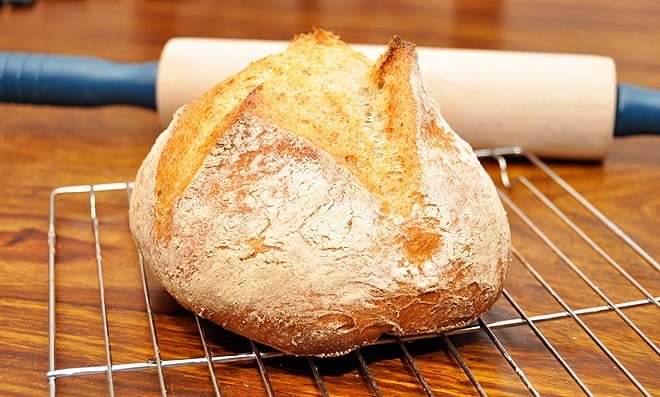So this recipe has been floating around for a long time, gracing the blogs and the tables of many a foodie. Personally, I was a bit skeptical. I mean, what is the point of making bread if you aren’t going to knead it, fuss over it, watch it rise, punch it around… Making homemade bread is about technique, timing, and experience. Naturally, it comes with some bragging rights. But this bread changes everything. Anyone who can use a wooden spoon can make it. It’s simplicity makes it such that absolutely everyone has the ability to make gorgeous loaves of crusty outered, tender innard-ed bread.
To make the dough, you mix everything in a bowl. That’s it. The initial rise takes two or more hours. But this rise doesn’t need to be babysat, as you let it grow until it collapses in on itself. Then you take the resulting gloriously yeasty, puffy pile of dough, stick it in a tub, pop it in the fridge, and saw off a hunk whenever you have a hankering for fresh, warm bread. Nothing to it.
The longer the bread stays in your fridge (up to about two weeks), the more flavourful it becomes and the larger the air holes will be. Others have said that it improves greatly by keeping it in the fridge for just 24 hours, and that the longer it is in there, the better it will be. I personally thought it was scrumptious the very first day, and with my patience deficiency, there was no way in heck it was going to last more than a few days.

The “five minutes a day” thing really only refers to the active time once the dough is prepared (i.e. cutting off a chunk, flouring it, and slashing it). It takes a bit more than five to mix up the initial batch – maybe five-and-a-half, six minutes? Then on the day you bake it, it needs to rest for at least 40 minutes once it is shaped. Plus about a half-hour in the oven. But no time will be spent grunting and fretting as you might do when making bread the traditional way…. which you may never do again, once you try making it this way!
Artisan Bread
Adapted from ”Artisan Bread in Five Minutes a Day,” by Jeff Hertzberg and Zoë François
- 1 1/2 tablespoons yeast
- 1 1/2 tablespoons salt coarse salt (kosher or sea salt)
- 3 cups water
- 6 1/2 cups unbleached, all-purpose flour, more for dusting dough (*you can replace about 1 to 1 1/2 cups of white flour with any whole grain flour with great results).
- Cornmeal
1. In a large bowl, mix yeast and salt into 3 cups warm water. Add flour, and stir to combine completely. Let dough rise in a warm place for at least two hours, until it rises and collapses (up to 5 hours – or even overnight won’t hurt it). The dough may be baked at this point, or refrigerated for later use.
2. Cover dough, but make sure it is not airtight – gases need to escape – and place in fridge. When you are ready to use it, throw a small fistful of flour on the surface and use a serrated knife to cut off a piece of the size you desire. (The authors recommend a 1 pound loaf – which means cutting off grapefruit-sized piece of dough). Turning the dough in your hands, stretch the surface of the dough and tuck in under. The surface will be smooth, and the bottom with be bunched.
3. Dust a pizza peel (or any flat surface – I use a rimless cookie sheet) with cornmeal. (This prevents sticking, and adds a nice, rustic crunch. You can use flour instead, but you’ll need to use a very generous dusting). Allow dough to rest in a warm place for 40 minutes – longer (up to an hour and a half) if you use some whole wheat flour in place of the white, or if you make a larger loaf.
4. Twenty minutes before baking, preheat oven to 450 degrees with baking stone (or overturned baking sheet) inside on the middle rack, plus a shallow pan on the top rack. Throw a small fistful of flour over the dough, slash it 2-4 times with a serrated knife (in a cross, a tic-tac-toe, or a fan), and slide it into the oven, onto the baking stone. Throw 1-2 cups of tap water into the shallow pan, and quickly shut the oven door to trap steam inside. Bake for 30 minutes, or until crust is well browned and bread sounds hollow when you knock on the bottom.












